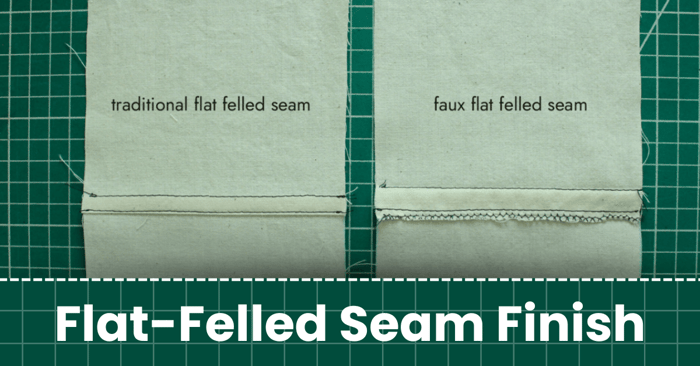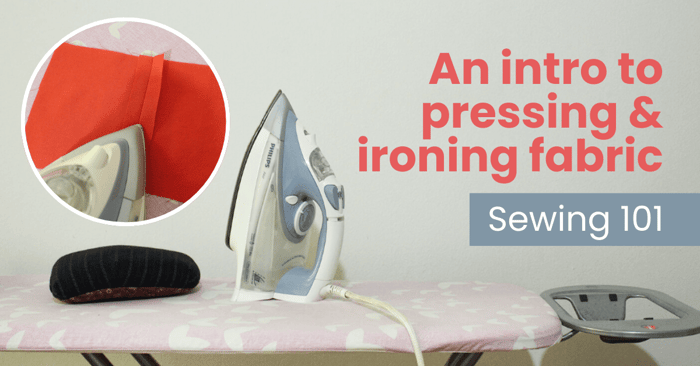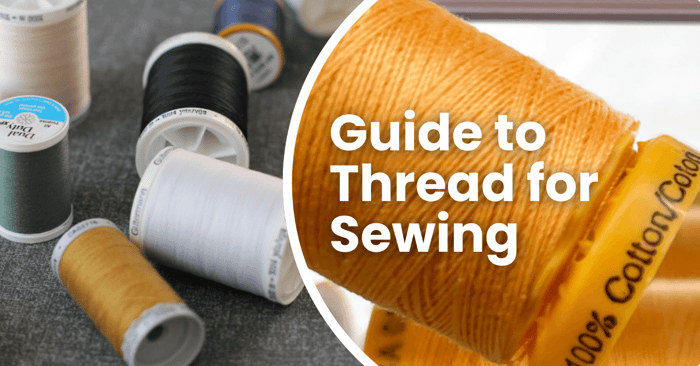
Flat-Felled Seam Finish | What it Is and How to Use It
The flat felled seam, among many other seam finishes, is widely used in the fashion industry but also by sewists to add strength and longevity to garments.
Industrial sewing machines typically have an automated system to finish this seam in just one step. But this technique is so worthy, and it can be done with some easy steps on your regular sewing machine.
In this comprehensive article, we will explore everything you need to know about the flat felled seam, where to use it, its anatomy, two step-by-step tutorials on how to sew this seam, and many tips on how to perfect it.

What is a flat felled seam?
A Flat felled seam is a strong and durable seam finish. It involves folding one edge of the fabric over the other, then enclosing the raw edges and topstitching the seam flat through all the fabric layers.
Where To Use Flat Fell Seams?
Flat felled seams are typically seen on jeans, other denim, workwear, sportswear, tailored men’s shirts, or any other type of garment that needs good durable seam finishes for a long time. So using fabrics such as cotton, denim, and even linen gives the best results.
For example, on jeans, the seams are found along the side seams and center back/front. On the picture: flat felled seam as a side seam on jeans.

Besides on straight seams, flat felled seams can be sewn on curved seams too, but the process is more complex, and a few tricks are needed in order for the seam to lay flat. In addition to being a technique that creates neat finishes inside and out, the flat felled seam can also be used as a decorative seam finish.
Flat felled on a man’s button-up shirt. These seams can be seen on the shoulder and around the armhole.

Flat felled seam on the back and the armhole of a leather jacket.

Is there a difference between a flat felled seam and a French seam?
The role of both of these techniques is to enclose raw edges and create a professional-looking finish, but they do differ in construction and appearance.
French seams are enclosed seams on the inside of the garment, and on the right side of the garment, it looks like a regular no-show stitch.
On the other side, the flat felled seam involves folding one edge of the fabric over the other. This way, the raw edges of the fabric are enclosed and sewn through all layers. Then it’s pressed flat and stitched to keep the seam nice and flat.
Sewing a Flat Felled Seam

PREPARATIONS
Seam allowance
A 1.5 cm (5/8”) seam allowance is recommended for flat felled seams. If you’re planning to add a flat felled seam and your pattern pieces have less seam allowance, be sure to add that extra amount that is needed.
You could also use the 1.25 cm (1/2″) seam allowance as well, but the flat felled seam may be trickier.
Sewing foot choice
A flat felled seam can be sewn without the use of any special pressure foot. So, the basic presser foot does the job just right.
On the other side, if a felling foot (also known as a lap seam foot) is one of the sewing machine accessories you may have, then this foot ensures consistent and neat flat felled seams. Depending on the brand, this foot is available in a 9mm, 6mm, and 4mm finished seam width.
This foot is specifically designed to sew flat felled seams, and its advantage compared to the regular presser foot is that it saves time as you do not need to fold and press.
The felling foot with a smaller groove is used for lightweight and delicate fabrics (4 mm finished size), and the wider ones are recommended and used on heavy-weight fabrics.

The edge foot can also be used and its guide aligns with the edge of the seam to give you perfectly even stitch lines.
TRADITIONAL FLAT FELLED SEAM
How to sew a traditional flat felled seam
- Place both corresponding fabric layers with right sides together and stitch 1.5 cm (5/8”) from the fabric raw edge.


Press the seam to one side.
- Trim one side of the seam allowance about 6mm (1/4”). If you’re just sewing a simple seam, trim either side, but in the case, you’re following a sewing pattern, refer to their sewing instructions.

Next, press the seam allowance, so that the wider seam is on the top, and the trimmed one is under.

- Fold the wide seam allowance under so that it wraps around the trimmed seam allowance and pin it in place or baste. Press.

- You can topstitch from the right or wrong side of your fabric. If sewing from the right side, be sure to baste to keep the fold in place.
- Edgestitch through the folded edge and all layers of the seam allowance. Try to stitch as close to the fold line as you can and press.
 *Optional – Stitch a second parallel row of topstitching next to the original seamline from the right side of the garment.
*Optional – Stitch a second parallel row of topstitching next to the original seamline from the right side of the garment.
FAUX FLAT FELLED SEAM
The faux flat felled seam (known also as mock flat felled seam) is a version of this seam finish that is usually used to create the same look but by removing some fabric bulk and decreasing the ironing time.
The raw edges are not enclosed but either serged or zig-zaged, which cuts in time, and as a result, it is quite preferred on heavy-weight fabrics.
How to sew the faux flat felled seam
- Place both fabric layers with right sides together and stitch 1- 1.5 cm (3/8-5/8”) from the fabric raw edge.

- Press the seam allowances open.

- Finish the seam allowance only on one side with a zig-zag or a serger and trim the unfinished seam allowance up to 6 mm.

Press the finished seam allowance over the trimmed seam allowance.

Place the garment on the right side and topstitch the seam allowance in place using a 1 cm (3/8”) seam allowance.

*Optional – To give the seam more strength but also for decoration purposes, topstitch another line 1/4″ (6 mm) from the first one.
The finished faux flat felled seam

Flat-felled seam TIPS
- Using the tool of your choice (a ruler or a sewing gauge), always be sure to mark the seam allowance correctly.
- Depending on the fabric choice, keep in mind to choose the right thread and needle size. If all three are in line, then the strength of the stitch but also the topstitching will be impeccable.
- As with any other sewing technique, pressing is a must, and in order to get a neat finish, press your seams after every step.
- If sewing flat felled seams for the first time, practice on different scraps; this way you will get to see the difference it makes depending on the fabric weight.
- Before trimming the seam allowance on one of the sides, press the seam allowance open and then trim. This way it will be easier to trim and not accidentally cut other fabric layers.
- Flat felled seams take time, especially the ones that need to be sewn on a curve. Take your time to achieve a consistent and neat seam throughout your project.
Exploring the flat felled seam on a denim jacket
As seen below, the denim jacket is one of those garments where the flat felled seam is widely used to create strong and durable seams but also for decorative purposes.
The red circles point out all the flat felled seams on the front of the jacket and the sleeves. The flat felled seams around the armhole, sleeve length, and shoulder, but also on the back (not in the picture), have been intentionally added to guarantee durability for a long time, also taking into consideration that denim is quite strong and wears off very slowly.
The flat felled seam at the bust and waist area mainly are for decorative purposes but also can be part of the jacket’s designs.

If we look more closely, we can notice the two types of flat felled seams mentioned earlier in the article: the traditional (red arrow) and the faux flat (green arrow).

Final thoughts on the flat felled seam finish
Among many other sewing techniques, the flat felled seam can be used with no special foot or the need for a serger or overlock. Take the time to go through our guide and practice the flat felled seam so your future projects have professional and neat finishes.
Thank you for joining us today to learn about the flat felled seam finish! Also be sure to check out our articles on the Hong Kong Seam Finish and French Seam Finish. Before you leave, make sure to sign-up for our newsletter below. You can also join our Facebook Group or follow us on Instagram. Happy Sewing!



